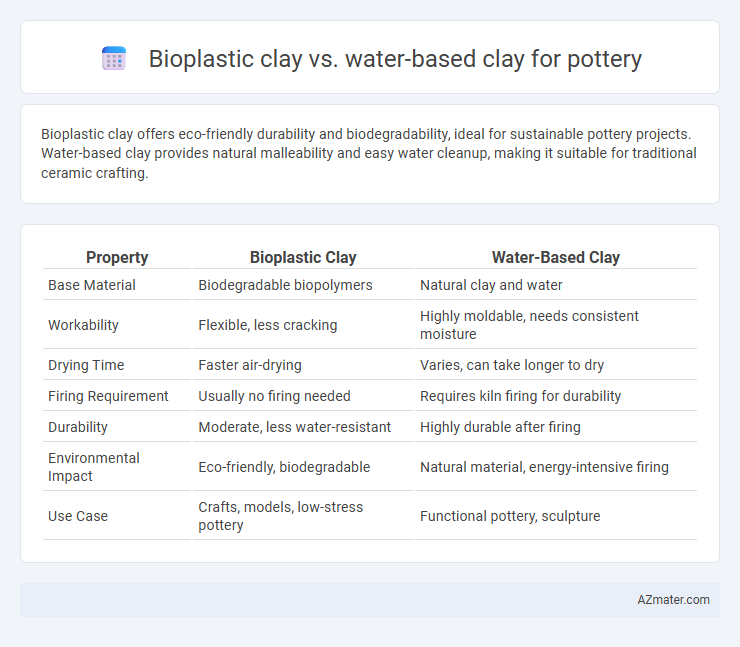Bioplastic clay offers eco-friendly durability and biodegradability, ideal for sustainable pottery projects. Water-based clay provides natural malleability and easy water cleanup, making it suitable for traditional ceramic crafting.
Table of Comparison
| Property | Bioplastic Clay | Water-Based Clay |
|---|---|---|
| Base Material | Biodegradable biopolymers | Natural clay and water |
| Workability | Flexible, less cracking | Highly moldable, needs consistent moisture |
| Drying Time | Faster air-drying | Varies, can take longer to dry |
| Firing Requirement | Usually no firing needed | Requires kiln firing for durability |
| Durability | Moderate, less water-resistant | Highly durable after firing |
| Environmental Impact | Eco-friendly, biodegradable | Natural material, energy-intensive firing |
| Use Case | Crafts, models, low-stress pottery | Functional pottery, sculpture |
Introduction to Bioplastic and Water-Based Clay
Bioplastic clay is an eco-friendly, biodegradable material made primarily from natural biopolymers such as cornstarch or cellulose, offering a sustainable alternative to traditional clays. Water-based clay, commonly used in pottery, consists of natural clay minerals mixed with water, providing easy moldability and smooth texture for shaping and sculpting. Both clays cater to different artistic and environmental needs, with bioplastic clay emphasizing eco-consciousness and water-based clay ensuring traditional functionality.
Material Composition: Bioplastic vs Water-Based Clay
Bioplastic clay is composed primarily of biodegradable polymers such as polylactic acid (PLA) derived from renewable resources like cornstarch, offering enhanced flexibility and environmental sustainability. Water-based clay, traditionally made from natural clay minerals combined with water, contains minerals like kaolinite, illite, and montmorillonite, providing plasticity and workability. The synthetic composition of bioplastic clay results in a non-toxic, moldable material that hardens without firing, whereas water-based clay requires kiln firing for permanent strength and durability.
Sustainability and Environmental Impact
Bioplastic clay offers a sustainable alternative in pottery by utilizing biodegradable materials that significantly reduce plastic waste and lower carbon emissions during production. Water-based clay, while natural and non-toxic, often requires extensive water use and energy-intensive kiln firing, impacting overall environmental sustainability. Choosing bioplastic clay supports eco-friendly crafting by minimizing reliance on non-renewable resources and enhancing biodegradability in disposal.
Workability and Handling Differences
Bioplastic clay offers superior workability compared to water-based clay due to its smooth, consistent texture that remains pliable without drying out quickly. Water-based clay requires constant moisture adjustment and can become sticky or crumbly, impacting handling during sculpting. The non-toxic and lightweight nature of bioplastic clay makes it easier to manipulate for detailed pottery work, while water-based clay demands more skill to maintain optimal hydration for softening and shaping.
Drying and Curing Processes
Bioplastic clay typically requires an extended drying period followed by heat curing or baking to achieve rigidity and durability, ensuring the polymer matrix solidifies properly. Water-based clay dries through water evaporation at ambient temperature, often needing several hours to days based on thickness and humidity, with no additional curing step beyond complete dryness. Understanding the drying and curing distinctions is essential for selecting the appropriate clay type depending on project timelines and final use requirements.
Strength and Durability of Finished Pieces
Bioplastic clay offers enhanced strength and durability in finished pottery pieces due to its polymer-based composition, making it less prone to cracking and breaking compared to water-based clay. Water-based clay, while easier to shape and more traditional, often requires careful drying and firing processes to achieve comparable strength and can be more susceptible to warping or damage over time. The polymer content in bioplastic clay provides superior resilience and long-term stability, ideal for functional and decorative pottery requiring durability.
Surface Finishes and Decorative Opportunities
Bioplastic clay offers a smooth, uniform surface finish that is ideal for fine detailing and intricate decorative techniques such as engraving and inlay work. Water-based clay tends to have a more porous texture, allowing for greater absorption of glazes and underglazes that enhance vibrant surface colors and varied finishes. Both clays provide diverse decorative opportunities, but bioplastic clay excels in precision work while water-based clay supports more experimental glazing and surface texture variations.
Safety and Non-Toxicity Considerations
Bioplastic clay offers significant safety advantages due to its non-toxic, chemical-free composition, making it ideal for use in environments with children or individuals sensitive to allergens. Water-based clay, while generally non-toxic, may contain additives or impurities that require careful handling to avoid skin irritation or respiratory issues. Choosing bioplastic clay enhances health safety by minimizing exposure to potentially harmful substances commonly found in some traditional water-based clays.
Cost Analysis and Availability
Bioplastic clay generally incurs higher costs due to its eco-friendly polymers and limited manufacturing scale, whereas water-based clay remains more affordable and widely accessible in retail and educational markets. Water-based clay benefits from mass production and abundant natural raw materials, reducing price variability significantly in comparison to bioplastic alternatives. Availability of bioplastic clay is often confined to specialty stores and online platforms, while water-based clay enjoys broader distribution, making it the cost-effective choice for mass pottery creation and educational purposes.
Choosing the Right Clay for Your Pottery Project
Bioplastic clay offers eco-friendly benefits with biodegradability and non-toxic ingredients, making it ideal for sustainable pottery projects. Water-based clay provides superior plasticity and easier shaping, preferred for traditional wheel-throwing and sculpture due to its flexibility and smooth texture. Choosing between bioplastic and water-based clay depends on priorities like environmental impact, workability, and the type of firing or drying techniques required for the final pottery piece.

Infographic: Bioplastic clay vs Water-based clay for Pottery
 azmater.com
azmater.com